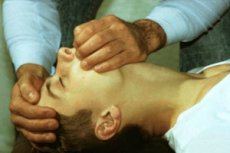Medical expert of the article
New publications
First emergency treatment for laryngospasm: algorithm of actions
Last reviewed: 04.07.2025

All iLive content is medically reviewed or fact checked to ensure as much factual accuracy as possible.
We have strict sourcing guidelines and only link to reputable media sites, academic research institutions and, whenever possible, medically peer reviewed studies. Note that the numbers in parentheses ([1], [2], etc.) are clickable links to these studies.
If you feel that any of our content is inaccurate, out-of-date, or otherwise questionable, please select it and press Ctrl + Enter.

One of the conditions for successful relief of laryngospasm is timely and correct provision of first aid.
- The first thing to do is to calm the patient down. To do this, use irritating actions: wet the face with water, pinch the skin, pat the back.
- It is necessary to provide fresh air. To do this, remove tight clothing, open a window in the room and give the victim some water.
- To stop an attack, you can induce a gag reflex by pressing on the root of the tongue or holding your breath for a couple of seconds.
- For a spasm that lasts longer than a minute, internal administration of a 0.5% potassium bromide solution is indicated.
If the above methods are ineffective, the seizure progresses and asphyxia begins, then tracheal intubation or tracheotomy is performed to ensure airway patency. This procedure can only be performed by a physician. If there are signs of cardiac arrest, resuscitation measures and indirect cardiac massage are performed. As soon as laryngospasm is relieved, the patient is given oxygen therapy.
Emergency care for laryngospasm
A severe form of laryngeal spasm with convulsions of the whole body and signs of asphyxia is a condition that requires emergency care, as its progression can lead to death.
Algorithm of action in case of laryngospasm:
- Place the victim on a flat surface as resuscitation may be required.
- To ease movement of the chest and lungs, loosen or remove clothing.
- Ensure the quietest possible environment and fresh air supply, as there is a risk of oxygen starvation.
- Wet the body and face with water, give the patient a cotton ball with ammonia or press on the root of the tongue. Such irritating actions stop the spasm.
- Since the spasm is associated with hypocalcemia, intravenous administration of calcium gluconate in a dosage of 5-10 ml of 10% solution is indicated.
- To restore airway patency, perform intubation or tracheotomy.
- If there is no pulse and the heart stops, indirect massage of the heart muscle is indicated.
After the patient's breathing is restored, he or she is taken by ambulance to the hospital for monitoring of vital signs and further examination.
How to relieve laryngospasm?
Treatment of laryngeal spasms in adults is difficult, but in some cases they pass on their own. Particular attention during an attack should be paid to primary emergency care.
In order to relieve laryngospasm, the patient should be provided with access to fresh air and a calm environment. Panic and hysteria of those around will lead to worsening respiratory failure. If the disorder is mild, the patient should be given cool water to drink and wet his face with it.
Convulsions are well stopped by using secondary irritants: patting on the back, pinching the skin, pressing on the root of the tongue. You can use ammonia or intravenous/intramuscular administration of anticonvulsants. If it is known for sure that the attack is caused by an allergen, then antihistamines and antiallergic drugs are necessary.
How to relieve laryngospasm at home?
The first thing you need to do if your loved one has laryngospasm is to call an ambulance. Before the doctors arrive, you should try to alleviate the patient's condition at home.
The victim should be placed in a horizontal position, remove clothing that is constricting the chest. Wet the face with cool water, give some liquid and provide a flow of fresh air. The environment should be calm so that the patient relaxes as much as possible. Light pats on the back, pinching the throat area, pressing on the root of the tongue and other irritating actions will be effective.


 [
[